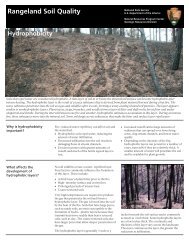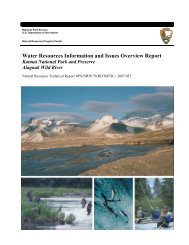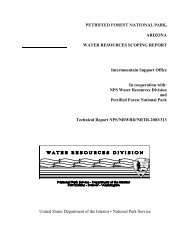Naphthalene, C1 - National Park Service
Naphthalene, C1 - National Park Service
Naphthalene, C1 - National Park Service
You also want an ePaper? Increase the reach of your titles
YUMPU automatically turns print PDFs into web optimized ePapers that Google loves.
different. The most probable human exposure would<br />
be occupational exposure, which may occur through<br />
dermal contact or inhalation at places where 2methylnaphthalene<br />
is produced or used [366].<br />
Atmospheric workplace exposures have been<br />
documented [366]. Non-occupational exposures would<br />
most likely occur via urban atmospheres,<br />
contaminated drinking water supplies and<br />
recreational activities at contaminated waterways<br />
[366].<br />
Hazards Summary [366]: The major hazards<br />
encountered in the use and handling of 1methylnaphthalene<br />
stem from its toxicologic<br />
properties. Toxic by all routes (ie, ingestion,<br />
inhalation, and dermal contact), exposure to this<br />
colorless liquid may occur from its use as a<br />
general solvent, as a chemical intermediate, or as<br />
a dye carrier. Effects from exposure may include<br />
flushing, headache, restlessness, fever, nausea,<br />
anorexia, diarrhea, skin irritation, corneal<br />
damage, oliguria, and anemia, hepatocellular<br />
injury, convulsions, and coma. 1-Methylnaphthalene<br />
is a moderate fire hazard. When heated to<br />
decomposition, this substance emits acrid smoke and<br />
fumes.<br />
Additional human health issues related to the<br />
naphthalene parent compound as well as two <strong>C1</strong><br />
naphthalenes (2-methylnaphthalene and 1methylnaphthalene)<br />
have been summarized by ATSDR<br />
[867].<br />
Br.Car: Brief Summary of Carcinogenicity/Cancer Information:<br />
Most of the information available is about the parent<br />
compound naphthalene itself rather than<br />
methylnaphthalenes. Alkyl substitution often confers or<br />
enhances carcinogenic potential of PAHs. A few examples:<br />
Very few alkyl PAHs have been broadly tested for<br />
carcinogenicity, but it is known that both<br />
dimethylbenzo(a)anthracene and its parent compound<br />
benzo(a)anthracene are carcinogenic<br />
[40,793,788,881]. Methylbenzo(a)anthracene is<br />
actually more carcinogenic than its parent compound<br />
benzo(a)anthracene, and dimethylbenzo(a)anthracene<br />
is still more carcinogenic [40].<br />
Both cholanthrene and its 3 methyl alkyl<br />
cholanthrene counterpart are carcinogenic [40,793].<br />
It is also known that alkylation does not<br />
significantly change phototoxicity [888] and that

















